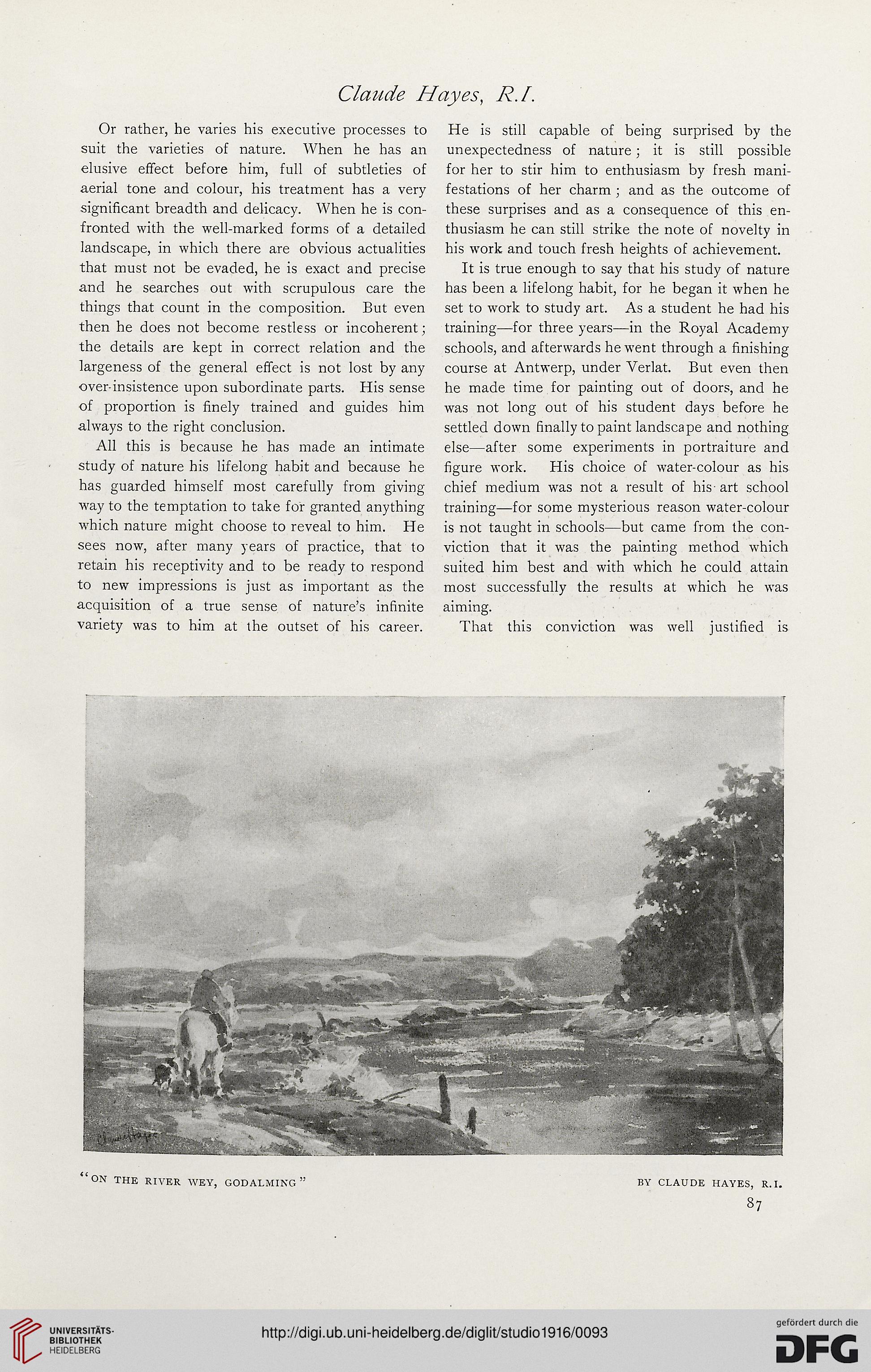Claude Hayes, R.l.
Or rather, he varies his executive processes to
suit the varieties of nature. When he has an
elusive effect before him, full of subtleties of
aerial tone and colour, his treatment has a very
significant breadth and delicacy. When he is con-
fronted with the well-marked forms of a detailed
landscape, in which there are obvious actualities
that must not be evaded, he is exact and precise
and he searches out with scrupulous care the
things that count in the composition. But even
then he does not become restless or incoherent;
the details are kept in correct relation and the
largeness of the general effect is not lost by any
over-insistence upon subordinate parts. His sense
of proportion is finely trained and guides him
always to the right conclusion.
All this is because he has made an intimate
study of nature his lifelong habit and because he
has guarded himself most carefully from giving
■way to the temptation to take for granted anything
which nature might choose to reveal to him. He
sees now, after many years of practice, that to
retain his receptivity and to be ready to respond
to new impressions is just as important as the
acquisition of a true sense of nature’s infinite
variety was to him at the outset of his career.
He is still capable of being surprised by the
unexpectedness of nature; it is still possible
for her to stir him to enthusiasm by fresh mani-
festations of her charm ; and as the outcome of
these surprises and as a consequence of this en-
thusiasm he can still strike the note of novelty in
his work and touch fresh heights of achievement.
It is true enough to say that his study of nature
has been a lifelong habit, for he began it when he
set to work to study art. As a student he had his
training—for three years—in the Royal Academy
schools, and afterwards he went through a finishing
course at Antwerp, under Verlat. But even then
he made time for painting out of doors, and he
was not long out of his student days before he
settled down finally to paint landscape and nothing
else—after some experiments in portraiture and
figure work. His choice of water-colour as his
chief medium was not a result of his art school
training—for some mysterious reason water-colour
is not taught in schools—but came from the con-
viction that it was the painting method which
suited him best and with which he could attain
most successfully the results at which he was
aiming.
That this conviction was well justified is
Or rather, he varies his executive processes to
suit the varieties of nature. When he has an
elusive effect before him, full of subtleties of
aerial tone and colour, his treatment has a very
significant breadth and delicacy. When he is con-
fronted with the well-marked forms of a detailed
landscape, in which there are obvious actualities
that must not be evaded, he is exact and precise
and he searches out with scrupulous care the
things that count in the composition. But even
then he does not become restless or incoherent;
the details are kept in correct relation and the
largeness of the general effect is not lost by any
over-insistence upon subordinate parts. His sense
of proportion is finely trained and guides him
always to the right conclusion.
All this is because he has made an intimate
study of nature his lifelong habit and because he
has guarded himself most carefully from giving
■way to the temptation to take for granted anything
which nature might choose to reveal to him. He
sees now, after many years of practice, that to
retain his receptivity and to be ready to respond
to new impressions is just as important as the
acquisition of a true sense of nature’s infinite
variety was to him at the outset of his career.
He is still capable of being surprised by the
unexpectedness of nature; it is still possible
for her to stir him to enthusiasm by fresh mani-
festations of her charm ; and as the outcome of
these surprises and as a consequence of this en-
thusiasm he can still strike the note of novelty in
his work and touch fresh heights of achievement.
It is true enough to say that his study of nature
has been a lifelong habit, for he began it when he
set to work to study art. As a student he had his
training—for three years—in the Royal Academy
schools, and afterwards he went through a finishing
course at Antwerp, under Verlat. But even then
he made time for painting out of doors, and he
was not long out of his student days before he
settled down finally to paint landscape and nothing
else—after some experiments in portraiture and
figure work. His choice of water-colour as his
chief medium was not a result of his art school
training—for some mysterious reason water-colour
is not taught in schools—but came from the con-
viction that it was the painting method which
suited him best and with which he could attain
most successfully the results at which he was
aiming.
That this conviction was well justified is




